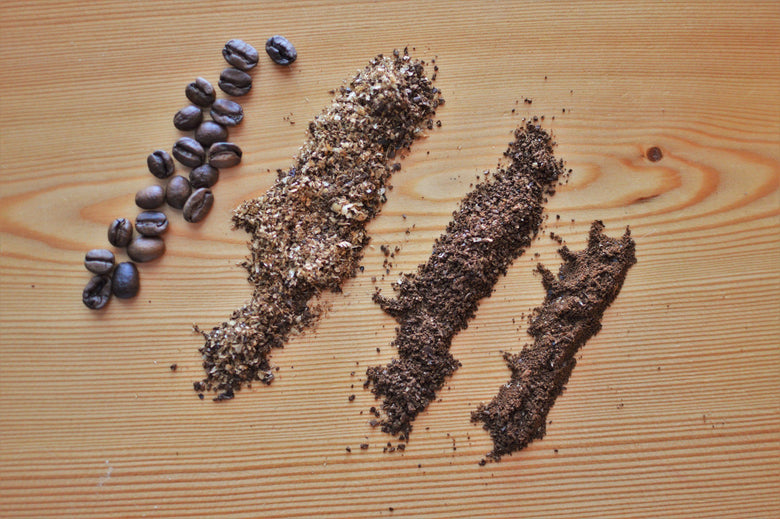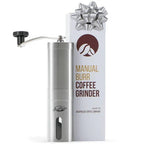If you’ve read many of our articles on JavaPresse, you are mega fans of the coffee grinder. It’s the most empowering coffee tool you can own.
Not only does it allow you to buy whole bean coffee (fresher, tastier, better in every way than pre-ground), it gives you the ability to grind those beans to any size you want to brew better coffee. And when you have that power over your beans, you can tailor the coffee grind size to work perfectly with whatever coffee brewer you’re using.
That’s a lot of power!
Many coffee lovers don’t understand how this process works, unfortunately. Granted, it’s not the easiest thing to figure out, but it’s soooo worth it.
Read: Why Your Coffee Grinder Is Your Most Important Coffee Gear
Your coffee will taste better. You’ll be more confident when you brew. Your daily mug will be more delicious and rewarding than ever.
Let me show you how to take advantage of this opportunity and reap the rewards.
How Coffee Grounds Work
As you know, coffee beans are ground to allow hot water to more easily extract flavors from them. Let’s go a little deeper.
The smaller the coffee ground, the less time it takes for water to penetrate all the way to the center. Thus, the more quickly the water extracts the acids, oils, solids, and other stuff from the ground. The larger the ground, the more time it takes to extract yummy things from it.
Let’s see this in a practical example:
French press brewing typically uses coarse (big) grounds and about four minutes. The result is rich, balanced coffee because it takes roughly four minutes for the water to extract just the right amount of tasty things from those large grounds.
Read: How To Read Coffee Packaging Like A Pro
However, with pour over brewing, it may only take a little over two minutes to brew using medium-fine grounds. Since the grounds are smaller, it doesn’t take as long to produce a balanced flavor.
Espresso brewing using super-fine grounds and only needs 25-35 seconds.
Remember this: the finer the grind, the quicker the water will extract things from the grounds and the less time you’ll need.
“Dialing In” Your Coffee’s Flavor Using Grind Size
Now, before I show you a real-world example of how you can use this knowledge for coffee troubleshooting, you need to have a basic understanding of flavor stages.
The first things to be extracted during coffee brewing are various acids. They’re sour, they’re intense, and they can even taste somewhat salty.
Read: How to Taste Coffee Acidity
Then come the aromatic oils, dissolved solids, and sugars. These things are much more pleasant on their own, but they give life to the acids when they’re extracted to create a richer, fuller flavor.
Bitter compounds are some of the last things to be extracted from the grounds. You want a small amount of these things to add flavor depth and to help round out the bite of the acids, but you want to avoid extracting too much of these.
There’s a sweet spot where all of these flavor compounds mix together to form a well-rounded, delicious flavor profile with tangy acids, sweet sugars, vibrant aromatics, rich flavors, and even a light layer of bitter low notes. This is coffee harmony.
Read: How to Taste Coffee Bitterness
If you don’t extract enough and don’t make it to that sweet spot, your coffee will be slightly overpowered by those bright acids. You’ll notice that the coffee’s just too tangy, sour, or salty.
If you extract too much and overshoot that sweet spot, your coffee will be overly bitter. Those bitter compounds will destroy the pleasant sugars and flavors, resulting in dullness.
Now, let’s see how this all works out in real life examples
A Specific Example With French Press Brewing
Let’s say you brew coffee with a french press. You use 20g of coffee beans that you grind at a 15 setting (hypothetically). You use 300g of water and brew for four minutes (a normal recipe).
You taste the coffee and notice it taste a little bitter. It’s just not as sweet or interesting as it could be - it seems a little dull.
You recall that bitter tasting coffee is a result of over extraction. Essentially, you pulled too much from the grounds. To fix the issue, next time you brew, you need to extract less.
Read: How To Pair Your Coffee Brewer With Its Perfect Grind Size
Since grounds extract quickly when they’re fine and slowly when they’re coarse, you decide you need to use a coarser coffee grind size to slow down the extraction.
You prepare to brew another french press with a 17 grind setting (2 notches coarser).
Now, as long as you don’t change the four minute brew time, you should have slightly less extracted coffee by the end of the brew.
You taste the coffee and find that it’s much more flavorful and balanced. Yum!
Here’s what happened:
- You extracted too much the first time
- You made your grounds slightly coarser so they wouldn’t extract so fast
- Your second french press tasted just right
See? It’s not so hard.
Let’s look at how it works with a slightly more complicated scenario.
A Specific Example With Pour Over Brewing
You brew coffee with a pour over cone. You use 20g of coffee ground at a 12 setting and 300g of water. You bloom for 30 seconds, finish pouring by 1:30, and finish draining at 1:50.
The coffee tastes a bit too acidic and tart. It doesn’t quite seem well-rounded.
You remember that acidic, sour coffee is the result of under extraction. Basically, you didn’t pull enough out of the coffee grounds. Next time, you need to extract more.
Read: How To Master The Water Pouring Technique For Pour Over Coffee
The solution is to grind a little finer using a 10 grind setting (2 notches finer).
With pour over brewing, changing the grind size does two things instead of one:
- The finer grounds will extract more quickly, requiring less time to brew a balanced mug
- The finer grounds will slow down the draining time, prolonging water coffee contact time
You brew the second pour over using the same technique as before. A 30-second bloom, finish pouring by 1:30. But this time, the draining doesn’t end ill 2:20 (a whole 30 seconds later).
You taste the coffee and find that it’s much more balanced and rich. The pleasant low notes round out those acids that were overpowering in the first mug.
Read: 5 Common Beginner Pour Over Coffee Questions Answered
Here’s what happened:
- You extracted too little the first time
- You ground the coffee slightly finer to quicken the extraction and reduce draining speed
- Your second pour over tasted much more well-rounded and yummy
It’s like a puzzle. You just gotta turn the variables the right way to get the full, clear picture.
Read: How Manual Coffee Brewing Can Change Your Life
---
Changing your coffee grind size is an excellent way to stay on top of your coffee’s flavor. When something’s not tasting as it should, you the power to change it.
It means you can leave less up to chance and take more control.
It means your daily brew won’t only taste great, but it’ll make you feel great since you have the confidence and skills needed to manipulate the results.
Your home coffee grinder is your most empowering tool, but it’s the beans that make it all possible.
High-quality, freshly roasted beans will be easy for coffee troubleshooting because the flavors are so crisp and clean. Older, low-grade beans, on the other hand, are hard to do this with because they hardly have any flavor to begin with.
To learn this skill, you need to stay stocked with great beans that are always freshly roasted.
Never settle for old supermarket coffee again. Buy beans that are ethically sourced provide dignifying wages to farm workers, and taste incredible.
Happy brewing!




